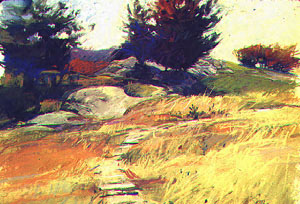"In the interplay of colors, sometimes you will get something that you never would have done on purpose."
|
 |
|||
|
Bill Suttles
|
||||
|
Bill Suttles, a graduate of the American Academy of Art in Chicago, began his career as an illustrator, but now devotes his time exclusively to painting. He uses uninhibited color and masterfully expressive strokes to transform rural landscapes of the Southeast into irresistible escapes of magical beauty that captivate and have restorative effects on those who view them. Borrowing from his enhanced vision, one seemingly possesses a window into a world more beautiful than our own.
Following is a detailed description of how he creates his paintings. He credits Coralie Tweed for teaching him the technique of combining gouache and pastel.
PREPARING THE PAPER:
GETTING STARTED:
|
||||
|
||||
|
GOUACHE UNDERPAINTING: He then loosely applies fluid gouache with inexpensive hardware brushes. While referring to his value study, he applies strong, uninhibited color. He emphasizes that thinning the paint, rather than adding white or yellow, works best with the pastels. When the entire paper is covered, he must then wait for it to dry. He confesses that he often accelerates the drying process with a hair dryer.
APPLYING PASTEL: When Bill Suttles has finished his painting it is difficult to discern where the gouache ends and the pastel begins. He explains it is the mat finish of the two mediums that allows for their perfect union. Yet, it is the contrast between the fluidity of the gouache and the definitive line of the pastel that gives his paintings such vitality. |
||||
You may contact Bill Suttles at: Bill Suttles 1295 Roxboro Drive Atlanta, GA 30324 | ||||
[ Artist Interviews | Artshow.com ]
Image copyright © Bill Suttles.
copyright © 1997 Artshow.com. All rights reserved.
